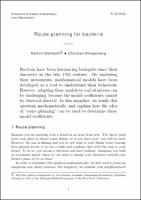| dc.contributor.author | Hellmuth, Kathrin | |
| dc.contributor.author | Klingenberg, Christian | |
| dc.contributor.editor | Tam, Matthew K. | |
| dc.contributor.editor | Egidi, Michela | |
| dc.contributor.editor | Randecker, Anja | |
| dc.date.accessioned | 2022-12-08T13:44:54Z | |
| dc.date.available | 2022-12-08T13:44:54Z | |
| dc.date.issued | 2022-12-08 | |
| dc.identifier.uri | http://publications.mfo.de/handle/mfo/3997 | |
| dc.description.abstract | Bacteria have been fascinating biologists since their discovery in the late 17th century. By analysing their movements, mathematical models have been developed as a tool to understand their behaviour. However, adapting these models to real situations can be challenging, because the model coefficients cannot be observed directly. In this snapshot, we study this question mathematically and explain how the idea of “route planning” can be used to determine these model coefficients. | en_US |
| dc.language.iso | en | en_US |
| dc.publisher | Mathematisches Forschungsinstitut Oberwolfach | en_US |
| dc.relation.ispartofseries | Snapshots of modern mathematics from Oberwolfach;2022-12 | |
| dc.rights | Attribution-ShareAlike 4.0 International | * |
| dc.rights.uri | http://creativecommons.org/licenses/by-sa/4.0/ | * |
| dc.title | Route planning for bacteria | en_US |
| dc.type | Article | en_US |
| dc.identifier.doi | 10.14760/SNAP-2022-012-EN | |
| local.series.id | SNAP-2022-012-EN | en_US |
| local.subject.snapshot | Analysis | en_US |
| dc.identifier.urn | urn:nbn:de:101:1-2022121211223696884513 | |
| dc.identifier.ppn | 1826791876 | |


